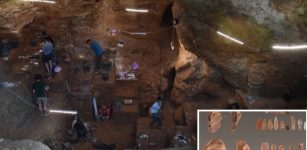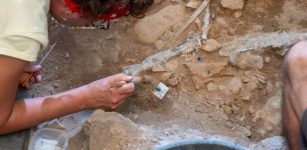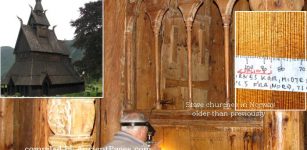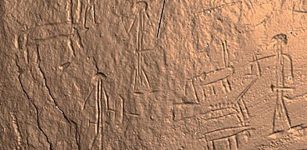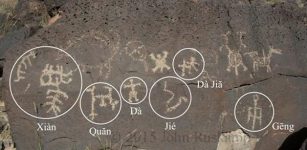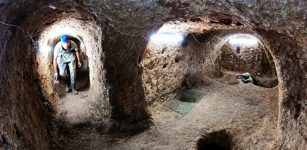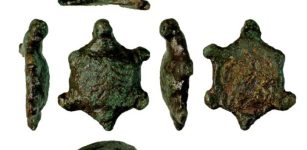Ancient Stone Kitchens And Unlocking A Treasure Trove Of Culinary Secrets
Conny Waters - AncientPages.com - Insights into the diets and traditions of the West’s ancient Indigenous communities can be now revealed thanks to researchers who recovered microscopic plant residues from bedrock metates in the area.
The mortar, pestle, and cutting board in your kitchen are modern versions of ancient manos and metates found in archaeological sites worldwide.
For thousands of years, Indigenous people have used depressions in rock, called metates, like this one in Oregon’s Warner Valley, to grind food. Photo by Stefania Wilks, University of Utah.
A mano is a hand-held stone tool used with a metate to grind food. The metate is a large flat stone or depression in bedrock. These open-air metates are common at archaeological sites, dating back 15, 500 years.
Researchers at the Natural History Museum of Utah are employing new techniques to extract microscopic plant residues from bedrock metates, aiming to gain a deeper understanding of the people who left them.
“People have lived here for time immemorial and have been processing native plants on ground stone tools for a long time too,” said archaeobotanist Stefania Wilks, a NHMU research assistant and University of Utah graduate student, referring to the Western U.S., where she conducts her research.
That research includes studying plants that people used for food and medicine to learn about traditional lifeways and how the landscapes have changed over time.
Now, Wilks and Louderback study starch granules, tiny plant cell structures storing energy as carbohydrates. These granules are smaller than a tenth of a millimeter.
The granules are too small to be seen with the naked eye, so scientists extract them from surfaces like ground stone, pottery, and basketry where plants were processed. Louderback believed bedrock metates might be an untapped starch source. Despite the rock's surface exposure possibly sweeping away or degrading granules over time, she thought small crevices could hide plant residue.
“Through their actions of grinding and mashing, people would have forced these starches down deeper into the stone,” Wilks explained.
Bedrock metates can be obvious or cryptic, depending on the rock type and grinding method. In Utah, exposed sandstone often forms oblong grooves. Other metates are circular, dish-shaped, or deep and round like modern mortars.
Anthropologists Lisbeth Louderback, left, and Stefania Wilks use an electric toothbrush to extract starch granules from a metate at an archaeological site in south-central Oregon in May 2022. Photo by Carolyn Temple, Bureau of Land Management.
Regardless of their shape, the metates tend to appear in groups or lined up in a row.
"They aren't sexy like an arrowhead," Wilks said, "…but they still contain valuable information about what plants people processed in the past."
Multiple bedrock metates are found along basalt outcrops in southern Oregon's uplands, alongside thousands of petroglyph panels and large populations of culturally significant plants, especially geophytes. Archaeologists once believed people only visited the uplands for hunting.
"We were up there testing to see if the bedrock metate surfaces were actually being used to process plants," Wilks said.
The team compared plant residues on the metate surface to those in its crevices. Using an electric toothbrush and water, they scrubbed the surface material. They then added a deflocculant to release particles from deep within the stone and used the toothbrush again to collect these particles. This procedure was repeated on nearby rocks not used as metates for comparison.
With samples in hand, the team turned to their microscopes to observe starch granules. Both the metate and control surfaces revealed virtually no granules. But the deeply-embedded samples contained hundreds.
"It increased our confidence that what we were seeing was direct evidence that different plant species with starchy organs were processed on the metate," Wilks recalled.
The team began identifying the plant species of the granules, a time-consuming task. They analyzed hundreds of starch granules from various plants to study their characteristics and compared them to current local plants. They narrowed many down to plant families, with some identified at the genus level. Common finds included carrot family members like biscuit root, wild grasses likely wild rye, and lily family plants—all important food sources for local Indigenous groups.
"Starch analysis is helpful in studying human diets of the past because some plant parts don't preserve in the archaeological record," Wilks said.
The new method of recovering starch granules offers researchers a way to study the role of plants in human diets. It also shows how bedrock metates, often overlooked at archaeological sites, hold valuable information about past human lifeways.
Written by Conny Waters - AncientPages.com Staff Writer







